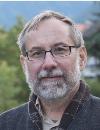
Stephen Pompea is an innovator in optics education having created many new optics education programs and teaching tools, including the Hands On Optics program. Since 2002, he has led the education and public outreach programs at the National Optical Astronomy Observatory and was name the first Observatory Scientist in 2014.
He did his undergraduate work in physics, space physics, and astronomy at Rice University, his Master’s work in physics teaching at Colorado State University, and his Ph.D. in astronomy at the University of Arizona. He developed space instruments for NASA, served as instrument scientist for the NASA NICMOS instrument for the Hubble Space Telescope at the University of Arizona, and as infrared instrument scientist for Gemini 8-meter telescopes project.
He has been PI or Co-I on many national science education projects in the areas of instructional materials development, public programs, informal science education, teacher and student research, and teacher professional development. Dr. Pompea has been working in optics education since he was in high school, when he designed programs for elementary school students inspired by high school teachers, one of whom later became president of the National Science Teachers Association. In 2011 Dr. Pompea was awarded the Esther Hoffman Beller Medal from the Optical Society of America for his contributions to optical sciences education and especially for his work in creating the Galileoscope student telescope kit. He is a Fellow of SPIE and the Optical Society of America. He is also the recent recipient of the Robert A. Millikan Medal from the American Association of Physics Teachers.
He is the author, coauthor, or editor of 15 books in optics and science education, over 120 papers, and has given over 350 presentations at professional conferences. Pompea is an adjunct faculty member of the University of Arizona with previous adjunct appointments at Colorado State University and the University of Arkansas.
He did his undergraduate work in physics, space physics, and astronomy at Rice University, his Master’s work in physics teaching at Colorado State University, and his Ph.D. in astronomy at the University of Arizona. He developed space instruments for NASA, served as instrument scientist for the NASA NICMOS instrument for the Hubble Space Telescope at the University of Arizona, and as infrared instrument scientist for Gemini 8-meter telescopes project.
He has been PI or Co-I on many national science education projects in the areas of instructional materials development, public programs, informal science education, teacher and student research, and teacher professional development. Dr. Pompea has been working in optics education since he was in high school, when he designed programs for elementary school students inspired by high school teachers, one of whom later became president of the National Science Teachers Association. In 2011 Dr. Pompea was awarded the Esther Hoffman Beller Medal from the Optical Society of America for his contributions to optical sciences education and especially for his work in creating the Galileoscope student telescope kit. He is a Fellow of SPIE and the Optical Society of America. He is also the recent recipient of the Robert A. Millikan Medal from the American Association of Physics Teachers.
He is the author, coauthor, or editor of 15 books in optics and science education, over 120 papers, and has given over 350 presentations at professional conferences. Pompea is an adjunct faculty member of the University of Arizona with previous adjunct appointments at Colorado State University and the University of Arkansas.
This will count as one of your downloads.
You will have access to both the presentation and article (if available).
Photonics education for a green future: connecting the dots of the Arizona STEM education experiment
Assessment of black and spectrally selective surfaces for stray light reduction in telescope systems
This will count as one of your downloads.
You will have access to both the presentation and article (if available).
This course is designed for scientists and engineers who want to share astronomy and optics in a fun and engaging manner in schools or in after school settings. You will learn how to teach optics using the Galileoscope, a high quality low-cost telescope designed for educational outreach. The Galileoscope was developed by a team of astronomers, optical engineers, and science educators during the International Year of Astronomy 2009 and was named as a "Gear of the Year" by amateur astronomers and has been nominated for an international education prize. The Galileoscope can be used as an optical bench to explore the optics of lenses as well as showing the wonders of the universe including craters on the Moon, the phases of Venus, the Galilean Moons of Jupiter and the rings of Saturn. Each participant will receive a Galileoscope and standards-based teaching materials. But the main outcome is to have fun building and using a Galileoscope.
This course presents a practical overview of surfaces currently available for stray light or thermal control.
It also covers white surfaces and blackbody surfaces for instrument calibration. It give a detailed look at the selection process, the optical characterization of surfaces using scatter and non-scatter measurements, terrestrial and space environmental effects on spectrally selective surfaces, special surfaces for ultraviolet and far infrared applications, and inexpensive surfaces for commercial systems.
View contact details
No SPIE Account? Create one

